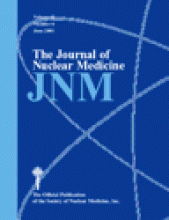TO THE EDITOR:
We agree with Nakamoto et al. (1) that targeting breast cancer cells with 131I, by use of the Na+/I− symporter (NIS), would represent a powerful and much needed method of directed therapy in breast cancer. To evaluate this concept, Nakamoto et al. transfected the rat NIS complementary DNA into a human breast cancer cell line and measured iodide accumulation under various conditions, both in cell culture and in a mouse xenograft model. As they point out, a major limitation of this approach is the absence of an effective method of selective transfection in vivo. Because mammary gland NIS (mgNIS) is upregulated in proliferating breast, we hypothesized and subsequently proved that it is also endogenously expressed in malignant breast tissue (2). mgNIS expression was shown in 20 of 23 biopsy specimens of invasive breast carcinoma compared with none of 8 normal samples from reductive mammoplasties. Furthermore, in 2 transgenic mouse models of breast cancer, significant uptake of the iodide analog 99mTc-pertechnetate was shown within the tumor by scintigraphic imaging, and this uptake was abolished by coinjection of perchlorate. The absence of iodide uptake by the nontransfected breast cancer line in Nakamoto’s work is consistent with findings that NIS is not constitutively expressed by MCF-7 cells in culture (3). The authors apparently assumed that human breast cancer does not express NIS in vivo.
We concur with Nakamoto et al. (1) that 131I iodide therapy may have a promising role to play in breast cancer. However, use of endogenous mgNIS may represent a more readily attainable means of delivery, as is being examined in our laboratory. Furthermore, because thyroid NIS and mgNIS are differentially regulated, it should be possible to adequately decrease thyroid iodide uptake without affecting breast cancer uptake through suppression of pituitary thyroid-stimulating hormone release. Therefore, when treating breast carcinoma using endogenous mgNIS, there may be no need for thyroidectomy, as suggested by Nakamoto et al.
REPLY:
We thank Dr. Zuckier and his colleagues for their thoughtful comments about our work (1). Their finding that the mammary gland Na+/I− symporter (mgNIS) is expressed during lactation and in breast cancer is a timely and important discovery (2). We believe that this is extremely significant and has direct implications for the diagnosis and therapeutic management of patients with breast cancer. It is also good news for these patients because it obviates the need for thyroidectomy. As was pointed out by Dr. Zuckier et al., we assumed that breast cancer cells did not take up iodide. When we began our work in 1999 our purpose was to investigate whether it would be possible to ablate transfected cells with radioiodide by increasing the accumulation of iodide in them. Although it turns out that most breast cancer tissue has its own mgNIS, we believe our approach has potential in various kinds of cancers that do not have their own NIS. Other researchers have used the same strategy for various cancers that do not accumulate iodide, and successful selective introduction and expression of the symporter gene have been reported (3,4). Although investigation by Dr. Zuckier’s group indicates that a major hurdle has been overcome for breast cancer, we have found few articles describing whether this strategy is really effective for treatment in vivo. It is encouraging that we have found several articles describing successful therapeutic effects assessed in vitro by clonogenic assay. Our preliminary biodistribution data showed that the estimated radiation dose from 131I was insufficient for xenografted tumors because of the rapid excretion of iodide from the transfected cells, although a clear scintigraphic image was obtained. We believe that the next important problem to resolve to make the technique applicable to treating many kinds of cancer is to devise a way to retain sufficient 131I within the cells to produce a therapeutic effect.







